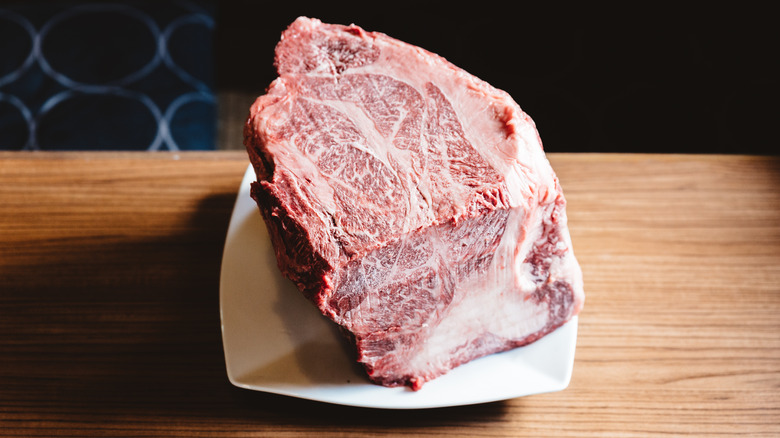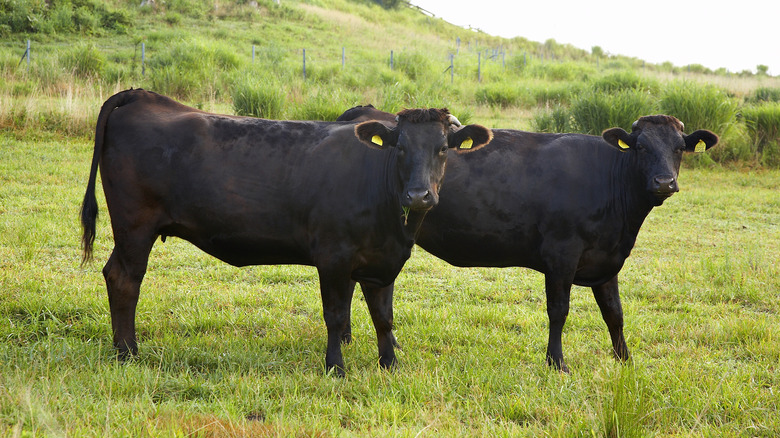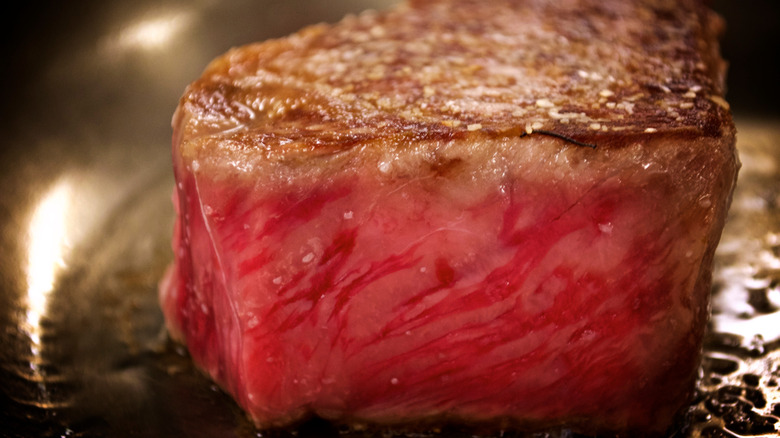Why A5 Wagyu Steak Is Considered The Height Of Luxury
Japan's Wagyu cattle are the source of some of the world's best beef. However, not all of this sought-after beef is considered to be of the same superior quality. The Japanese Meat Grading Association (JMGA) is the ultimate arbiter, and according to its grading system, A5 Wagyu is the only meat that makes an A-plus steak.
What makes A5 Wagyu so special? The A5 grade means that this meat is at the highest level in terms of color, texture, and marbling (intramuscular fat). The latter, in fact, is the signature aspect of Wagyu A5, as its ultra-fine marbling patterns translate to juicy steaks bursting with umami flavor and a tender, "unparalleled buttery texture," per Wagyuman. The degree of marbling in A5 Wagyu is extremely rare — it's present in under 1% of all Japanese steaks — and it's a big part of the reason these cuts often command prices upwards of $100 per pound.
The A5 Wagyu steak grade thus represents the height of culinary luxury. It's a menu highlight at high-end steakhouses worldwide, where it's available in cuts like ribeye, strip, and filet mignon.
How the grading system for Wagyu beef works
The term "yield," when applied to beef, refers to the percentage of high-quality cuts that can be sourced from a given cow relative to its weight. In Japan, the Japanese Meat Grading Association (JMGA) gives letter grades to differentiate the yield capabilities for Wagyu beef. The A grade, for example, is given to animals with a yield of 72% or higher. Cattle with lesser percentages could be given a B or C letter grade. This system differs slightly from the one used by the U.S. Department of Agriculture (USDA), in which yield is graded numerically from 1 to 5, with 1 indicating the highest yield.
While the letter A represents quantity, the number 5 in A5 Wagyu refers solely to quality. Cattle are scored by the JMGA according to several factors, notably marbling content and meat color. The number 1 represents the poorest quality of meat in this measurement scale, while the number 5 is the best. The USDA, by contrast, grades meat quality using descriptors like prime, choice, and select.
So, A5 Wagyu is a grade given to cattle that are optimal in terms of both quantity of meat and quality. Only four different Japanese cattle breeds are considered Wagyu-worthy, and the breeding of these animals is tightly controlled. Neither the cattle nor their DNA can be exported. However, there are Wagyu cattle in America, thanks to exports before the Japanese ban in 1997.
Tips for cooking A5 Wagyu steak
Because A5 Wagyu is not ordinary meat, it shouldn't be cooked like other cuts of steak. That doesn't necessarily mean the process is more complicated, just a little different, due to the meat's high fat content. For instance, the marbled fat in A5 Wagyu has a famously low melting point (only 75 degrees Fahrenheit), so the steaks should go right from the refrigerator to the skillet to prevent overcooking. However, the first step is salting. This should take place at least one hour prior, and up to three hours beforehand is acceptable. More salt should be used than with an ordinary steak, again, due to the high fat content, which allows more salt to be absorbed into the meat.
Sorry, grillmasters, the grill isn't the place to cook A5 Wagyu. Instead, you'll want to preheat your skillet in the oven at a setting of 400 degrees Fahrenheit. When it's hot, shift it to a burner set on high. Then, and only then, remove the steaks from the refrigerator to sear. Oil is optional, but if you do choose to add any, safflower oil is the recommended option due to its high smoke point.
After a resting period of about five minutes, you'll be ready to enjoy the height of culinary luxury with your exquisitely rich A5 Wagyu steak.



